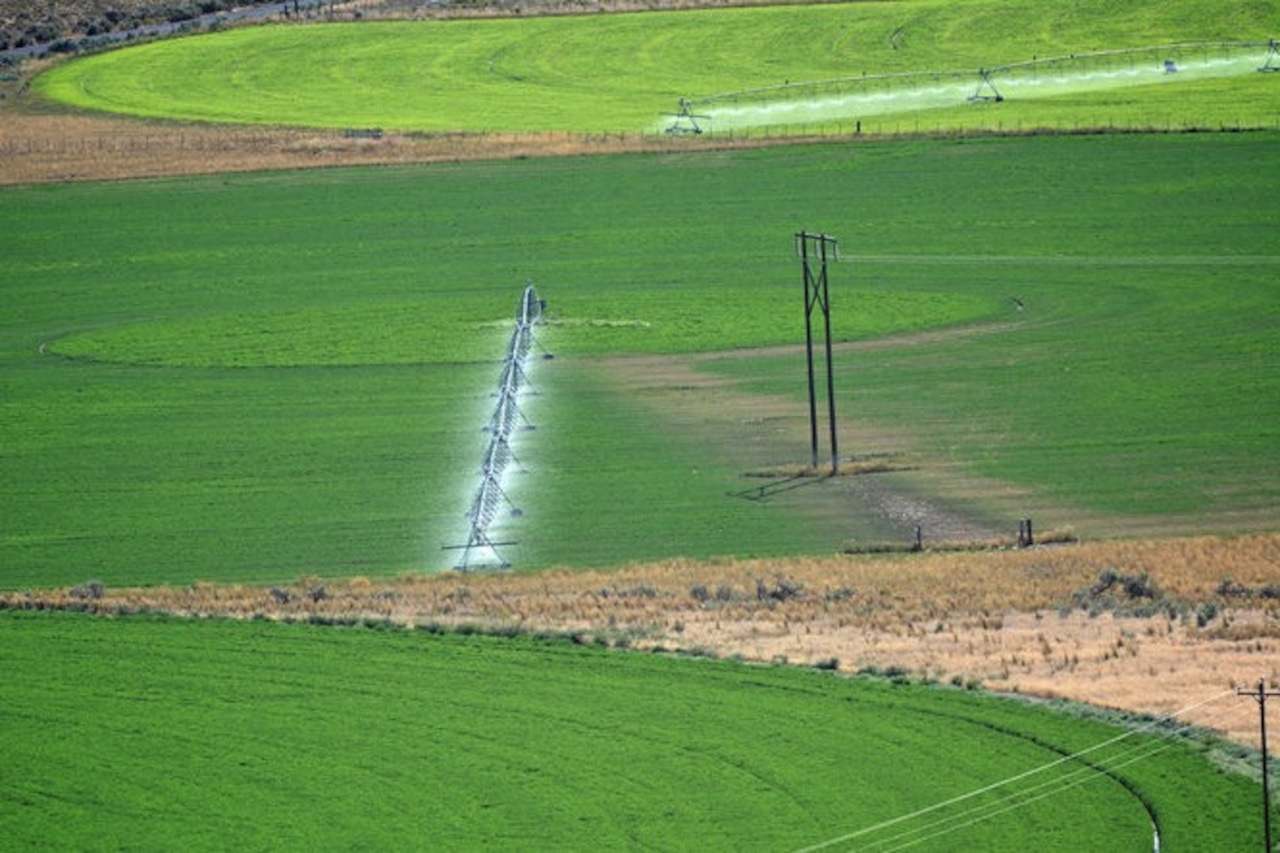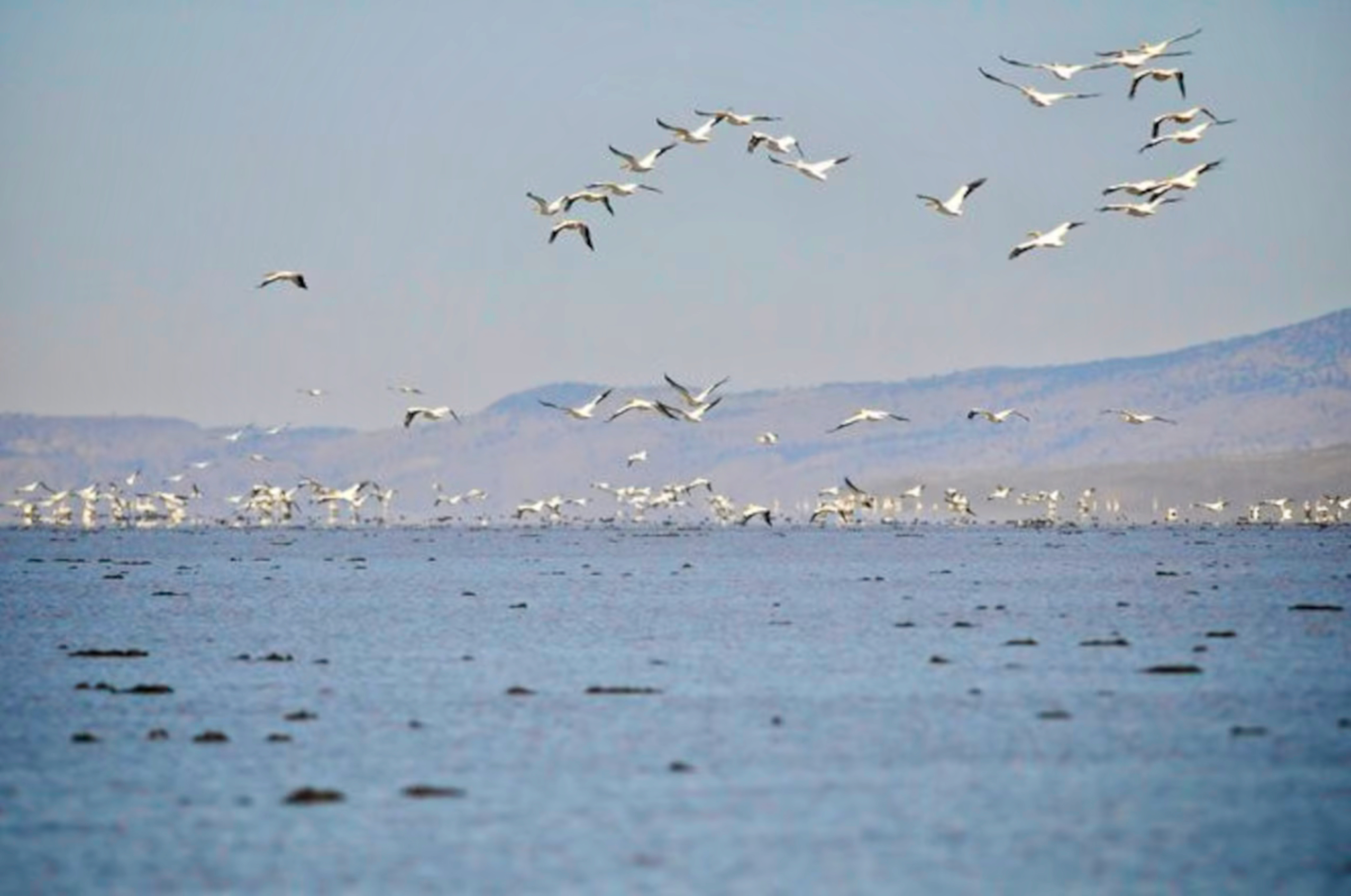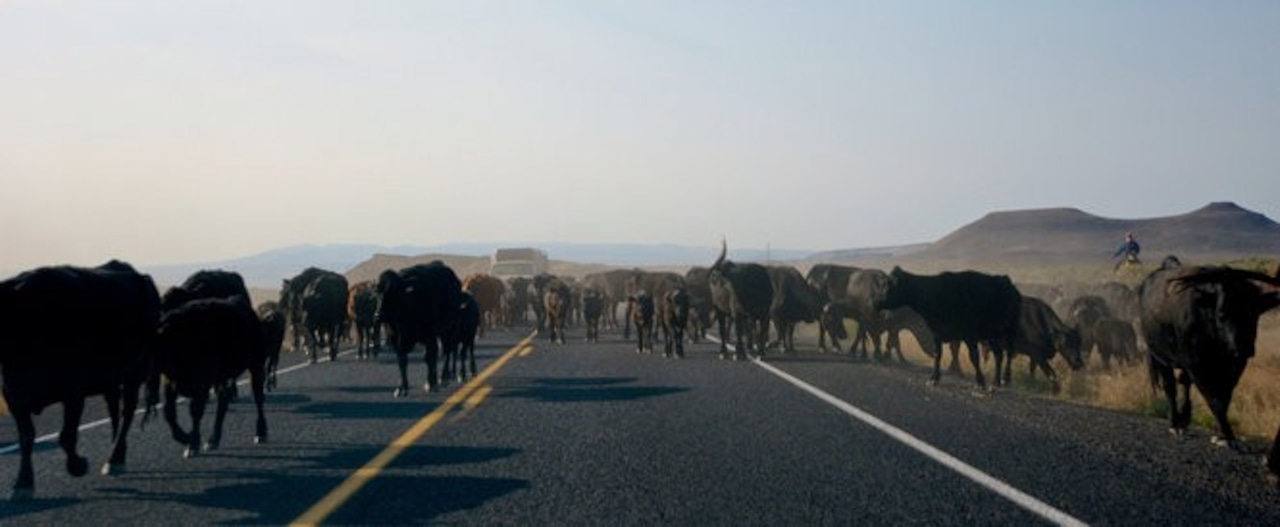By Kelly House | Aug. 26, 2016 | The Oregonian: Draining Oregon
Rancher Harold Knieriem thought his days of worrying about water would end with retirement. No more angst when the skies dry up or a mild winter dollops too little snow on the mountains, leaving his cattle to dine on withered grass.
Then the irrigation pivots started springing up around his small patch of land, drawing water from deep underground and painting bright green circles of alfalfa on the desert floor. The 76-year-old began to fret.
Would all those high-powered pumps draw down his household well? He and his wife, Alice, need the water to drink and to bathe. It would cost them thousands of dollars to drill deeper.
“I have no idea how much time it has left,” he says of the well behind the couple’s modest ranch-style home. “Then all the money you thought you’d retire and do stuff with is gone.”
As drought and economic opportunity prompt growers to look underground for new water to sustain their crops, it’s exposing a fatal flaw in Oregon’s water management. Across much of the state, the agency charged with rationing Oregon’s water supply lacks solid numbers on the natural reservoirs beneath Earth’s surface.
Knieriem suspects there isn’t enough water down there to sustain what’s happening in southeastern Oregon’s Harney Valley.
State records show regulators shared Knieriem’s suspicions for nine years, but continued allowing irrigators to dig new wells. Now state officials admit the evidence suggests they overshot. They abruptly stopped processing new applications for water last year, setting off alarm bells across the basin.
Ivan Gall, field services administrator for the Oregon Water Resources Department, said agency officials lacked the data to take action sooner and are working hard to catch up.
“We’re doing the best that we can with the resources we have,” Gall said.
Oregon regulators habitually appropriate groundwater without first making sure the added stress won’t drain an aquifer. Even when they have reason to suspect harm will come, they sometimes give out permits anyway. The result is groundwater shortages that, with better science or greater caution, could have been prevented.
The Harney Valley is the latest casualty.
Trouble in Harney County
Since the homestead days of the mid-1800s, this high desert valley has been, by necessity, about beef. Harney County has 14 cattle for every human.
“Cattle and hay in this county are life,” said Shane Otley, a local rancher who sits on a committee responding to the water declines. “This is the only resource we have.”
“You take that away, you’re undoing us,” said Harney County Judge Steve Grasty, the county’s elected administrator. “Undoing the economics, undoing the people here.”
Irrigated agriculture remained rare here, even as river siphons enabled farmers to grow watermelons on the Columbia River and onions on the Idaho border. Across much of the Harney Valley, the average year’s rainfall is less than eight inches. Flowing water is limited to two rivers that by midsummer are little more than glorified creeks. All of it drains to Malheur Lake, a massive wetland oasis that forms the cornerstone of Malheur National Wildlife Refuge.
Cattle in the region grazed mostly on rangeland grasses, which grow naturally in the desert.
But as the West’s worst drought in recent history sent hay and beef prices soaring from $2.53 per pound of ground beef in 2011 to $4.24 in 2015, a new economic opportunity opened up for landowners in Harney County.
Alfalfa was in huge demand.
Word got out that money could be made by digging a well, plotting a field and growing alfalfa. You could feed the hay to your own cattle, or sell it in other parts of the world that raise livestock.
Water beneath the surface was abundant and free. Obtaining permission to dig was so easy, many landowners started drilling before seeking the state’s consent. State regulators didn’t seem to mind, said Andy Root, an irrigator who acknowledged drilling a well without state authorization and now risks losing his water, given the state’s stance on new permits.
“The entire valley has done it for many, many years,” Root said.
In a matter of years, ranchers have swapped tens of thousands of acres of rangeland for irrigated forage crops. Newcomers arrived: Washington dairy operators, Lake County hay growers and ranch corporations headquartered in California and Idaho. One lists a Cheyenne, Wyoming, street address described in numerous media reports as a hub for shell companies that nameless owners use to stash cash and avoid taxes.
Land permitted for groundwater irrigation in Harney County rocketed from about 60,000 acres in 2005 to more than 95,000 last year. In the past 15 years, landowners have added more pumping capacity than the entire quarter-century preceding, state records show.
But at the very moment that ranchers were pumping more water from the deep soil than ever before, less was falling from the sky to percolate back down. Snowpack in the basin remained thin and melted early, prompting drought conditions for the past four summers.
Someone needed to decide whether there was enough water for all the new irrigators.
Repeated Warnings
Michael Zwart, a veteran hydrogeologist with the Oregon Water Resources Department, voiced alarm at what he saw happening in the Harney Valley.
Nearly every application to draw groundwater in the region crossed his desk. Zwart’s role was to document whether the new extraction would harm area streams or lower the water table.
Zwart raised concerns about pumping at least 33 times starting in 2007, records show.
Most of the approvals came from Tim Wallin, the department’s water rights program manager, on behalf of department directors Phil Ward and later Tom Byler.
Byler, the current director, declined to be interviewed for this story through a spokeswoman, and Ward did not return a phone call. The agency, in a statement, said it approves permits based not simply on reports from reviewers like Zwart, but also on information the applicant and others may submit later in the process.
Zwart had been through water shortages before. He was a lead researcher on declines in groundwater in northeastern Oregon’s Umatilla Basin a quarter-century earlier.
In August 2007, Zwart was reviewing an application to irrigate 350 acres outside the city of Burns when he noticed a nearby well had lost 20 feet of water in the past two decades. He noted the issue in his review and sent it up the chain of command. Wallin granted the permit.
Rather than turn away applicants, Gall, the department’s regional manager for far eastern Oregon at the time, suggested around 2008 that the agency start attaching a notice to permits. The notice said that the agency reserved the right to curb water usage if wells showed continuous or dramatic drops. Regulators have imposed this type of condition on owners of more than 2,000 groundwater permits in Oregon, but they have used it against only two permit holders.
On Jan. 27, 2009, Zwart reviewed an application from a farmer who wanted to irrigate 125 acres of alfalfa east of Burns. He noted nearby residents had voiced concern that neighboring wells might be siphoning water from one another.
Wallin granted the permit.
Just four months later, Zwart expressed his personal reservations directly when evaluating a request to pump up to 78 million gallons a year.
“I am concerned,” he wrote in the May 2009 public-interest review, “that additional development of ground water in the area will result in long-term water level declines and increased potential for interference between wells.”
But Zwart had limited evidence to justify his stance because the state has not closely studied Harney County’s groundwater. So he hedged, telling his bosses he didn’t have enough information to deem the resource overtapped.
Six months later, Zwart spoke up again. Someone had requested a permit to pump up to 948 million gallons a year to irrigate 1,000 acres. The rancher envisioned eight pivot sprinklers, which typically support circles of alfalfa up to a half-mile wide.
This time, Zwart wrote that well development near the property “raises concern regarding the potential for the groundwater to be over-appropriated when the proposed wells are constructed.” Wallin issued the permit.
State scientists years ago documented their belief that a well-pumping boom in the Harney Valley could be affecting Malheur Lake, a vital stopover for migratory birds. Now, regulators with the Oregon Water Resources Department have clamped down on well development in the valley while they study its impacts on the water table. They plan to include the lake in a five-year analysis of the valley’s groundwater system.
By November 2011, Zwart was highlighting a potentially more dire consequence: Area wells could be robbing water from Malheur Lake.
The important but imperiled waterway is a crucial stopover for migratory birds and a sacred site for the Burns Paiute Tribe. Protected under federal law, the lake encompasses 80,000 acres at times but shrinks to nothing in the worst drought years. Less water to feed the lake from below would further cloud its future.
As groundwater drilling continues, Zwart wrote, “It is likely that there will be some increasing impacts to the level of Malheur Lake.”
In the ensuing years, Zwart and his colleagues continued to warn that the Harney Valley’s water table was lowering.
Over time, Zwart’s superiors stopped issuing permits in two isolated areas to the south and southeast of Burns. But the state continued processing permits to drill everywhere else, even as the conservation group WaterWatch of Oregon formally challenged five permit applications starting in mid-2014.
The giveaway of Harney Valley’s groundwater was “a water supply train wreck” in the making, WaterWatch attorney Lisa Brown said.
A year passed before department managers announced, in June 2015, that they might have granted too many permits. The public declaration came nearly eight years after Zwart first raised concerns.
“The development got ahead of the data collection,” Gall, the state groundwater manager, said at the time.
Suddenly, the Harney Valley’s seemingly endless pipeline of new water permits was all but cut off. People who owned wells began to wonder if they’d be allowed to continue using them.
Rusty Inglis, president of the Harney County Farm Bureau, has served as a key liaison between state water officials and farmers in the area, where regulators say they may have given irrigators permission to pump more groundwater than the aquifers can sustain.
Uncertainty Festers
The uncertainty that followed the state’s moratorium on new wells is another blow to a community already jarred by political and economic turmoil.
In the past two years alone, Harney County has weathered a massive wildfire that wiped out nearly 400,000 acres of rangeland, land use restrictions to protect a desert bird called the sage grouse, a prolonged drought and a 41-day armed occupation of the Malheur refuge that upended local life and pitted neighbors across an ideological chasm.
Ranching and alfalfa were helping to revive the local economy, which suffered after the collapse of the timber industry. Now, there are reports of household wells drying up. Farmers who had counted on being able to dig new wells are weighing their options.
“We’ve just been hit right and left,” said Harney County Farm Bureau President Rusty Inglis. Add all those factors up, “and pretty soon it’s tragic.”
Residents and irrigators alike told The Oregonian they’re frustrated that the state didn’t catch the problem sooner.
Senior department managers including Gall, Deputy Director Doug Woodcock, Senior Policy Coordinator Racquel Rancier and spokeswoman Diana Enright defended the agency’s actions.
Gall said circumstances in the Harney Valley made it “easier to get to yes” on well permits, creating a perfect storm for things to go wrong. The valley’s demand for groundwater shot up so suddenly, Gall said, that state officials had little time to ponder the impacts.
State rules call for special scrutiny of wells that are within a mile of a stream, but Harney Valley streams are so sparse that few wells trigger that restriction. The rules allow curbs on drilling that will have a “substantial” impact on any river or lake, regardless of distance, but the main body of water threatened by drilling in the Harney Valley would be Malheur Lake. It is so large that no single well would have a substantial impact.
State rules allow regulators to consider the cumulative impact of many wells on a place like Malheur Lake. But Woodcock said the department typically opts not to.
Managers said that because the state has no estimate of water supplies beneath Harney Valley other than a 1968 federal study, they didn’t know how much pumping the valley could withstand. Because they have kept few observation wells to track water levels, water managers had little ability to watch out for declines.
Denying ranchers’ requests for water would be difficult without good data to back it up, Woodcock said.
If state managers took that step and further research proved them wrong, he said, “What about all those people that we have denied over the years because we were operating on an incomplete data set?”
But Woodcock’s agency also didn’t ask for more money to get the data that would answer questions its scientists raised about Harney Valley groundwater. Gall said that’s because the department anticipated rejection. The economic recession had gutted state agency budgets, he said, and “there were just no resources available.”
After shutting down the valley to new pumping applications, the state launched a study of its groundwater. It’s scheduled to be finished in 2020.
If the new study finds current pumping is either lowering the water table or draining Malheur Lake, big problems could arise. The lake and surrounding wildlife refuge have long been a source of resentment for some ranchers who believe the federal government shouldn’t own water rights or limit cattle grazing there. Ammon Bundy’s recent armed standoff at the refuge headquarters emboldened many who share that view.
Harney Valley residents and ranchers can only hope that halting new wells was enough to solve the problem. If not, state regulators could start rolling back the amount of water that existing irrigators are legally entitled to use.
Landowners owe millions on loans they took out for digging wells, laying pivots and buying farm equipment. Some would have to abandon their business plans. Their land values would drop. Ranches could go under.
The last thing this community needs, locals say, is another issue that pits the environment’s needs against ranchers’ livelihoods.
For now, Malheur refuge manager Chad Karges won’t speculate on what happens if pumping is harming the lake.
“Depending who you talk to right now, some people speculate it’s connected and others say it isn’t,” Karges said. “We’re waiting on the study.”
This article originally appeared in the Aug. 26, 2016, issue of the Oregonian’s Draining Oregon series.




